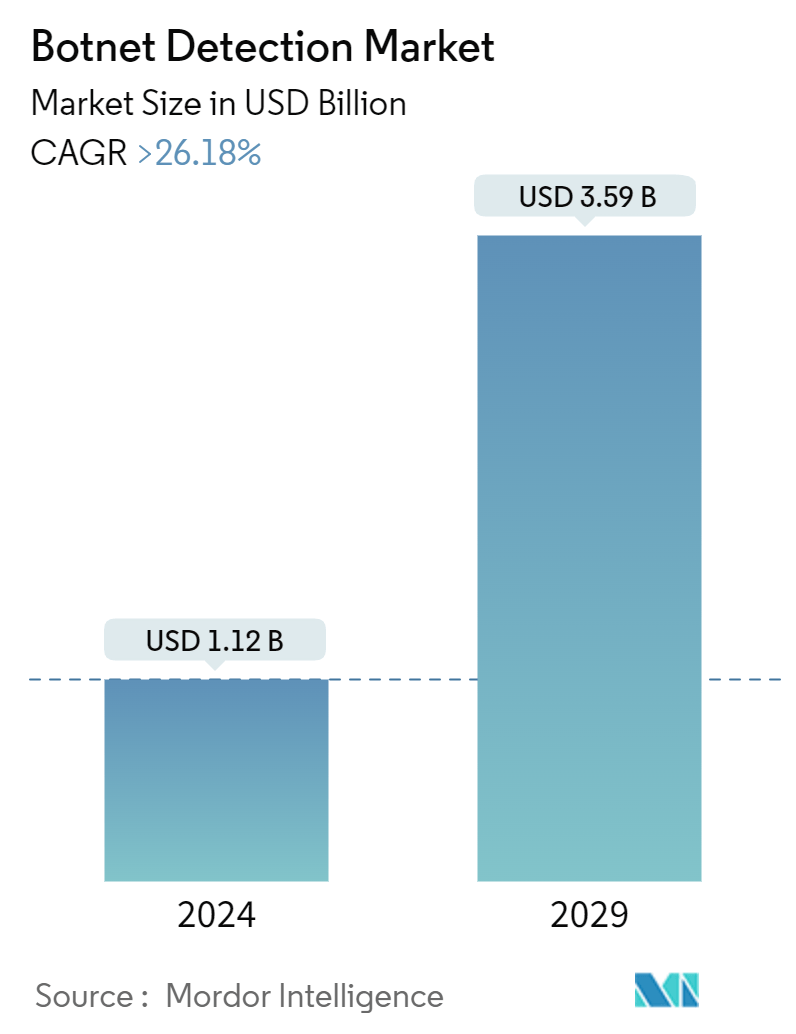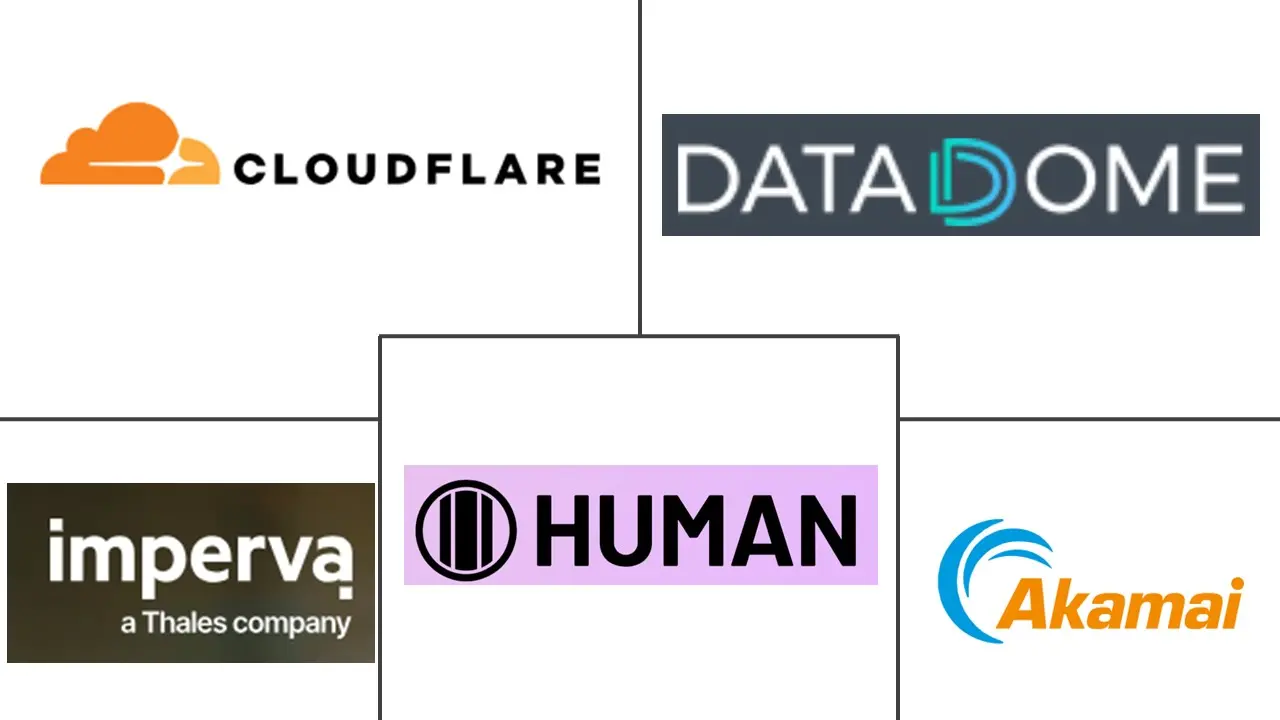Market Size of Botnet Detection Industry

| Study Period | 2019 - 2029 |
| Market Size (2024) | USD 1.12 Billion |
| Market Size (2029) | USD 3.59 Billion |
| CAGR (2024 - 2029) | > 26.18 % |
| Fastest Growing Market | Asia Pacific |
| Largest Market | North America |
| Market Concentration | Low |
Major Players
*Disclaimer: Major Players sorted in no particular order |
Botnet Detection Market Analysis
The Botnet Detection Market size is estimated at USD 1.12 billion in 2024, and is expected to reach USD 3.59 billion by 2029, at a CAGR of greater than 26.18% during the forecast period (2024-2029).
- Cybersecurity professionals and technology firms worldwide are increasingly focusing on botnet detection. As global technology advances, the risk of its misuse also increases. Botnet attacks infringe on user privacy, allowing third parties to control individual computers. With the rising capabilities of cybercriminals, botnets have emerged as a primary threat, capable of infiltrating any internet-connected device worldwide.
- The recent Internet of Things (IoT) technology surge has introduced more endpoints for potential attackers. This evolving landscape has led to a more frequent emergence of new distributed denial of service (DDoS) bots.
- With the rise of mobile devices and cloud computing as prime attack surfaces, malicious bots have found it easier to conceal their activities. While hackers have traditionally employed these bots for financial gain, their current uses have expanded to include industrial espionage and even election manipulation. Consequently, companies are intensively cataloging and analyzing these attacks to devise effective counter-strategies.
- The integration of physical security with IP networks has broadened the attack surface for cybercriminals. These criminals have evolved, shifting from targeting individual user accounts or specific regions to dominating entire internet entities.
- Despite these advancements, companies must grapple with a significant vulnerability: a shortage of skilled cybersecurity professionals to thwart such attacks. In response, companies are not only hiring and training new cybersecurity experts to understand the evolving nature of botnets and detection software. Still, they are also pursuing mergers with major market players to bolster their service offerings and product range.
- The rapid shift to remote work during the COVID-19 pandemic, along with increased reliance on digital tools, has inadvertently created opportunities for cybercriminals. This change has resulted in a noticeable increase in cyber threats, especially botnet-driven attacks aimed at remote workers, vulnerable endpoints, and online infrastructures.
Botnet Detection Industry Segmentation
A botnet comprises interconnected devices on the public internet, often including compromised workstations, servers, and Internet of Things (IoT) devices, all affected by malicious software or malware. A specific attacker or group typically controls these botnets, using them mainly for criminal or malicious activities. To counter these threats and protect their assets, companies implement preventive software designed to detect such attacks.
The botnet detection market is segmented by component (solution, service), deployment type (on-premise, cloud), organization size (SMEs, large enterprises), and end-user vertical (retail, BFSI, travel and hospitality, IT and telecom, and media and entertainment), and geography (North America [United States and Canada], Europe [United Kingdom, Germany, France, and Rest of Europe], Asia-Pacific [China, India, Japan, and Rest of Asia-Pacific], Rest of the World [Latin America and Middle East and Africa]). The report offers market forecasts and size in value (USD) for all the above segments.
| By Component | |
| Solution | |
| Service |
| By Deployment Type | |
| On-premise | |
| Cloud |
| By Organization Size | |
| SMEs | |
| Large Enterprise |
| By End-user Vertical | |
| Retail | |
| BFSI | |
| Travel and Hospitality | |
| IT and Telecom | |
| Media and Entertainment | |
| Other End-user Verticals (Education, Healthcare, and Real Estate) |
| By Geography*** | |||||
| |||||
| |||||
| |||||
| Australia and New Zealand | |||||
| Latin America | |||||
| Middle East and Africa |
Botnet Detection Market Size Summary
The botnet detection market is experiencing significant growth, driven by the increasing prevalence of cyber threats and the evolving landscape of technology. As cybercriminals become more adept at exploiting vulnerabilities in internet-connected devices, the demand for robust botnet detection solutions is rising. The proliferation of IoT devices and the rise of mobile and cloud computing have expanded the attack surface, making it easier for malicious bots to operate. This has led to a surge in botnet attacks, including distributed denial of service (DDoS) attacks, which have targeted major companies and infrastructure globally. The media and entertainment sector, in particular, is witnessing rapid growth in botnet detection adoption due to the rising incidence of ad fraud and other malicious activities that threaten brand integrity and revenue.
North America is poised to be a leading region in the botnet detection market, fueled by substantial investments in cybersecurity solutions and a strong focus on research and development. The region's growth is further supported by stringent government measures against botnet threats and increasing awareness of data privacy issues. The market is moderately competitive, with major players dominating and new entrants seeking to capture market share through strategic partnerships and acquisitions. Companies are actively enhancing their product offerings and capabilities to address the evolving threat landscape. The ongoing digital transformation and the need for robust security measures across various sectors are expected to drive the market's expansion in the coming years.
Botnet Detection Market Size - Table of Contents
-
1. MARKET DYNAMICS
-
1.1 Market Overview
-
1.2 Introduction to Market Drivers and Restraints
-
1.3 Market Drivers
-
1.3.1 Increasing Number of Connected Devices
-
1.3.2 Increasing Need For Security against Botnet in Organizations
-
1.3.3 Increasing Usage of APIs By Online Businesses
-
-
1.4 Market Restraints
-
1.4.1 Lack of Education among Users and Low Usage of Tools
-
1.4.2 Use of Conventional BOT Protection Methods, Such as Captcha Or Create Account
-
-
1.5 Industry Attractiveness - Porter's Five Force Analysis
-
1.5.1 Threat of New Entrants
-
1.5.2 Bargaining Power of Buyers/Consumers
-
1.5.3 Bargaining Power of Suppliers
-
1.5.4 Threat of Substitute Products
-
1.5.5 Intensity of Competitive Rivalry
-
-
1.6 Technology Overview
-
-
2. MARKET SEGMENTATION
-
2.1 By Component
-
2.1.1 Solution
-
2.1.2 Service
-
-
2.2 By Deployment Type
-
2.2.1 On-premise
-
2.2.2 Cloud
-
-
2.3 By Organization Size
-
2.3.1 SMEs
-
2.3.2 Large Enterprise
-
-
2.4 By End-user Vertical
-
2.4.1 Retail
-
2.4.2 BFSI
-
2.4.3 Travel and Hospitality
-
2.4.4 IT and Telecom
-
2.4.5 Media and Entertainment
-
2.4.6 Other End-user Verticals (Education, Healthcare, and Real Estate)
-
-
2.5 By Geography***
-
2.5.1 North America
-
2.5.1.1 United States
-
2.5.1.2 Canada
-
-
2.5.2 Europe
-
2.5.2.1 United Kingdom
-
2.5.2.2 Germany
-
2.5.2.3 France
-
-
2.5.3 Asia
-
2.5.3.1 China
-
2.5.3.2 India
-
2.5.3.3 Japan
-
-
2.5.4 Australia and New Zealand
-
2.5.5 Latin America
-
2.5.6 Middle East and Africa
-
-
Botnet Detection Market Size FAQs
How big is the Botnet Detection Market?
The Botnet Detection Market size is expected to reach USD 1.12 billion in 2024 and grow at a CAGR of greater than 26.18% to reach USD 3.59 billion by 2029.
What is the current Botnet Detection Market size?
In 2024, the Botnet Detection Market size is expected to reach USD 1.12 billion.

